Yash Vardhan Pant
University of California Berkeley
GenPlan: Generative sequence models as adaptive planners
Dec 11, 2024Abstract:Offline reinforcement learning has shown tremendous success in behavioral planning by learning from previously collected demonstrations. However, decision-making in multitask missions still presents significant challenges. For instance, a mission might require an agent to explore an unknown environment, discover goals, and navigate to them, even if it involves interacting with obstacles along the way. Such behavioral planning problems are difficult to solve due to: a) agents failing to adapt beyond the single task learned through their reward function, and b) the inability to generalize to new environments not covered in the training demonstrations, e.g., environments where all doors were unlocked in the demonstrations. Consequently, state-of-the-art decision making methods are limited to missions where the required tasks are well-represented in the training demonstrations and can be solved within a short (temporal) planning horizon. To address this, we propose GenPlan: a stochastic and adaptive planner that leverages discrete-flow models for generative sequence modeling, enabling sample-efficient exploration and exploitation. This framework relies on an iterative denoising procedure to generate a sequence of goals and actions. This approach captures multi-modal action distributions and facilitates goal and task discovery, thereby enhancing generalization to out-of-distribution tasks and environments, i.e., missions not part of the training data. We demonstrate the effectiveness of our method through multiple simulation environments. Notably, GenPlan outperforms the state-of-the-art methods by over 10% on adaptive planning tasks, where the agent adapts to multi-task missions while leveraging demonstrations on single-goal-reaching tasks.
Adaptformer: Sequence models as adaptive iterative planners
Nov 30, 2024Abstract:Despite recent advances in learning-based behavioral planning for autonomous systems, decision-making in multi-task missions remains a challenging problem. For instance, a mission might require a robot to explore an unknown environment, locate the goals, and navigate to them, even if there are obstacles along the way. Such problems are difficult to solve due to: a) sparse rewards, meaning a reward signal is available only once all the tasks in a mission have been satisfied, and b) the agent having to perform tasks at run-time that are not covered in the training data, e.g., demonstrations only from an environment where all doors were unlocked. Consequently, state-of-the-art decision-making methods in such settings are limited to missions where the required tasks are well-represented in the training demonstrations and can be solved within a short planning horizon. To overcome these limitations, we propose Adaptformer, a stochastic and adaptive planner that utilizes sequence models for sample-efficient exploration and exploitation. This framework relies on learning an energy-based heuristic, which needs to be minimized over a sequence of high-level decisions. To generate successful action sequences for long-horizon missions, Adaptformer aims to achieve shorter sub-goals, which are proposed through an intrinsic sub-goal curriculum. Through these two key components, Adaptformer allows for generalization to out-of-distribution tasks and environments, i.e., missions that were not a part of the training data. Empirical results in multiple simulation environments demonstrate the effectiveness of our method. Notably, Adaptformer not only outperforms the state-of-the-art method by up to 25% in multi-goal maze reachability tasks but also successfully adapts to multi-task missions that the state-of-the-art method could not complete, leveraging demonstrations from single-goal-reaching tasks.
Enhancing Safety in Mixed Traffic: Learning-Based Modeling and Efficient Control of Autonomous and Human-Driven Vehicles
Apr 10, 2024
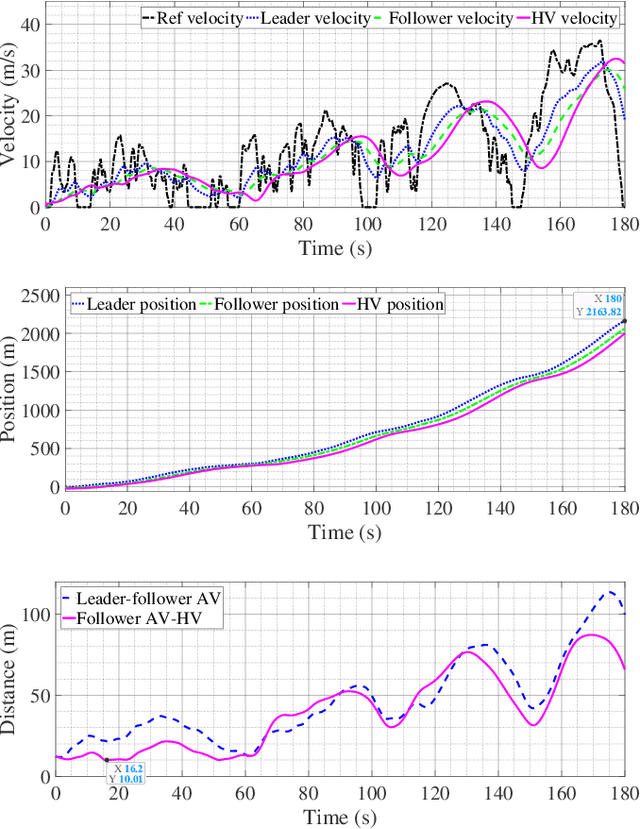
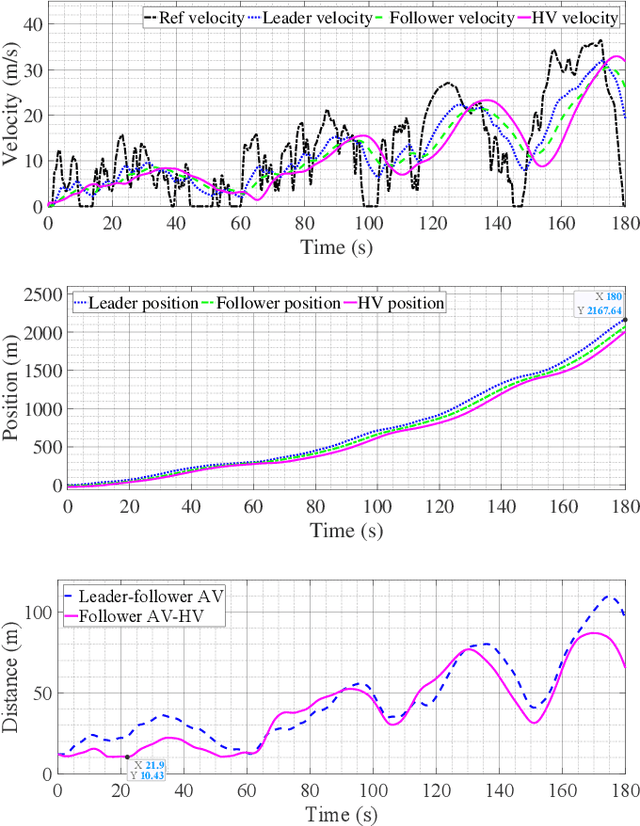
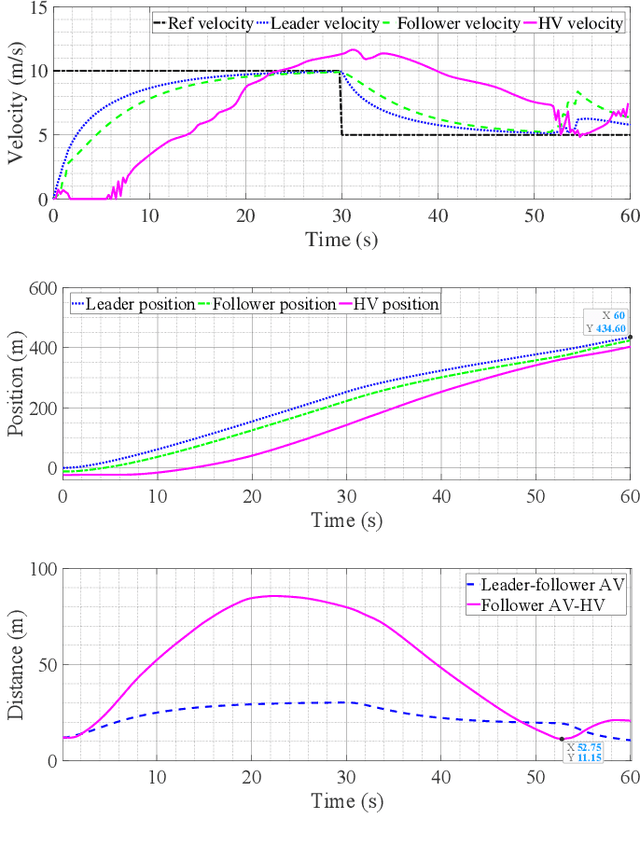
Abstract:With the increasing presence of autonomous vehicles (AVs) on public roads, developing robust control strategies to navigate the uncertainty of human-driven vehicles (HVs) is crucial. This paper introduces an advanced method for modeling HV behavior, combining a first-principles model with Gaussian process (GP) learning to enhance velocity prediction accuracy and provide a measurable uncertainty. We validated this innovative HV model using real-world data from field experiments and applied it to develop a GP-enhanced model predictive control (GP-MPC) strategy. This strategy aims to improve safety in mixed vehicle platoons by integrating uncertainty assessment into distance constraints. Comparative simulation studies with a conventional model predictive control (MPC) approach demonstrated that our GP-MPC strategy ensures more reliable safe distancing and fosters efficient vehicular dynamics, achieving notably higher speeds within the platoon. By incorporating a sparse GP technique in HV modeling and adopting a dynamic GP prediction within the MPC framework, we significantly reduced the computation time of GP-MPC, marking it only 4.6% higher than that of the conventional MPC. This represents a substantial improvement, making the process about 100 times faster than our preliminary work without these approximations. Our findings underscore the effectiveness of learning-based HV modeling in enhancing both safety and operational efficiency in mixed-traffic environments, paving the way for more harmonious AV-HV interactions.
Learning-Based Modeling of Human-Autonomous Vehicle Interaction for Enhancing Safety in Mixed-Vehicle Platooning Control
Mar 16, 2023Abstract:As autonomous vehicles (AVs) become more prevalent on public roads, they will inevitably interact with human-driven vehicles (HVs) in mixed traffic scenarios. To ensure safe interactions between AVs and HVs, it is crucial to account for the uncertain behaviors of HVs when developing control strategies for AVs. In this paper, we propose an efficient learning-based modeling approach for HVs that combines a first-principles model with a Gaussian process (GP) learning-based component. The GP model corrects the velocity prediction of the first-principles model and estimates its uncertainty. Utilizing this model, a model predictive control (MPC) strategy, referred to as GP-MPC, was designed to enhance the safe control of a mixed vehicle platoon by integrating the uncertainty assessment into the distance constraint. We compare our GP-MPC strategy with a baseline MPC that uses only the first-principles model in simulation studies. We show that our GP-MPC strategy provides more robust safe distance guarantees and enables more efficient travel behaviors (higher travel speeds) for all vehicles in the mixed platoon. Moreover, by incorporating a sparse GP technique in HV modeling and a dynamic GP prediction in MPC, we achieve an average computation time for GP-MPC at each time step that is only 5% longer than the baseline MPC, which is approximately 100 times faster than our previous work that did not use these approximations. This work demonstrates how learning-based modeling of HVs can enhance safety and efficiency in mixed traffic involving AV-HV interaction.
Gaussian Process Learning-Based Model Predictive Control for Safe Interactions of a Platoon of Autonomous and Human-Driven Vehicles
Nov 09, 2022Abstract:With the continued integration of autonomous vehicles (AVs) into public roads, a mixed traffic environment with large-scale human-driven vehicles (HVs) and AVs interactions is imminent. In challenging traffic scenarios, such as emergency braking, it is crucial to account for the reactive and uncertain behavior of HVs when developing control strategies for AVs. This paper studies the safe control of a platoon of AVs interacting with a human-driven vehicle in longitudinal car-following scenarios. We first propose the use of a model that combines a first-principles model (nominal model) with a Gaussian process (GP) learning-based component for predicting behaviors of the human-driven vehicle when it interacts with AVs. The modeling accuracy of the proposed method shows a $9\%$ reduction in root mean square error (RMSE) in predicting a HV's velocity compared to the nominal model. Exploiting the properties of this model, we design a model predictive control (MPC) strategy for a platoon of AVs to ensure a safe distance between each vehicle, as well as a (probabilistic) safety of the human-driven car following the platoon. Compared to a baseline MPC that uses only a nominal model for HVs, our method achieves better velocity-tracking performance for the autonomous vehicle platoon and more robust constraint satisfaction control for a platoon of mixed vehicles system. Simulation studies demonstrate a $4.2\%$ decrease in the control cost and an approximate $1m$ increase in the minimum distance between autonomous and human-driven vehicles to better guarantee safety in challenging traffic scenarios.
DEC-LOS-RRT: Decentralized Path Planning for Multi-robot Systems with Line-of-sight Constrained Communication
Mar 04, 2022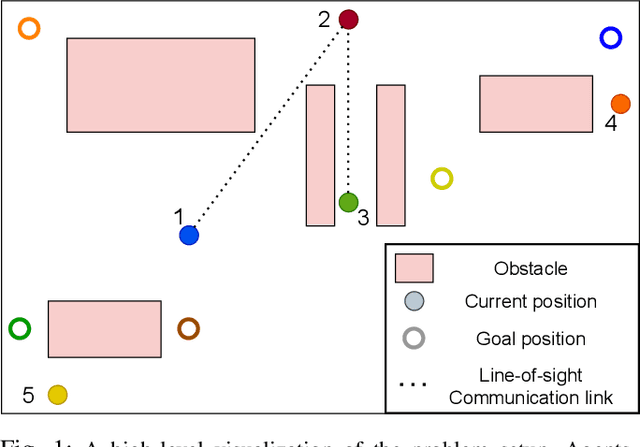
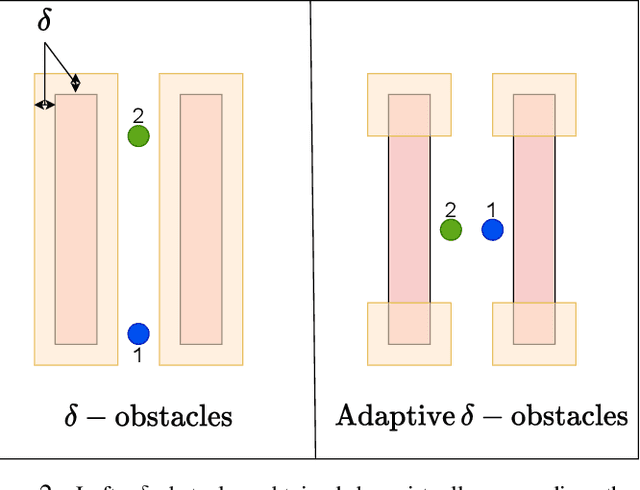
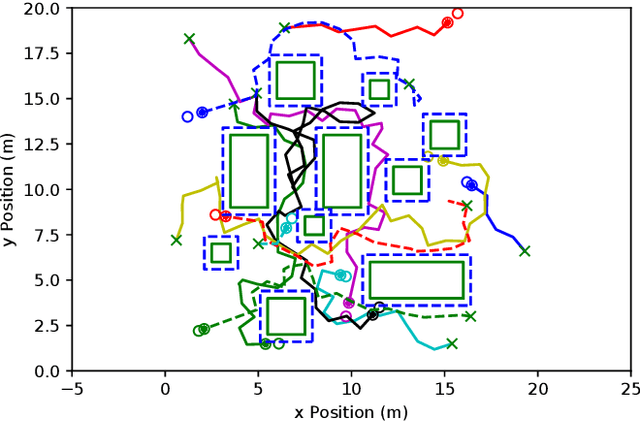
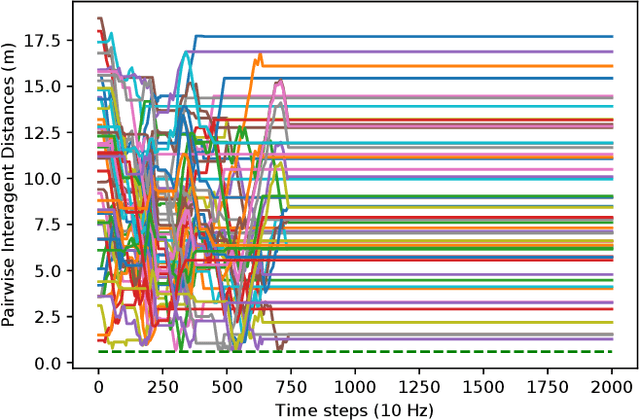
Abstract:Decentralized planning for multi-agent systems, such as fleets of robots in a search-and-rescue operation, is often constrained by limitations on how agents can communicate with each other. One such limitation is the case when agents can communicate with each other only when they are in line-of-sight (LOS). Developing decentralized planning methods that guarantee safety is difficult in this case, as agents that are occluded from each other might not be able to communicate until it's too late to avoid a safety violation. In this paper, we develop a decentralized planning method that explicitly avoids situations where lack of visibility of other agents would lead to an unsafe situation. Building on top of an existing Rapidly-exploring Random Tree (RRT)-based approach, our method guarantees safety at each iteration. Simulation studies show the effectiveness of our method and compare the degradation in performance with respect to a clairvoyant decentralized planning algorithm where agents can communicate despite not being in LOS of each other.
* 8 pages, 8 figures, Presented at CCTA 2022
Learning-'N-Flying: A Learning-based, Decentralized Mission Aware UAS Collision Avoidance Scheme
Jan 25, 2021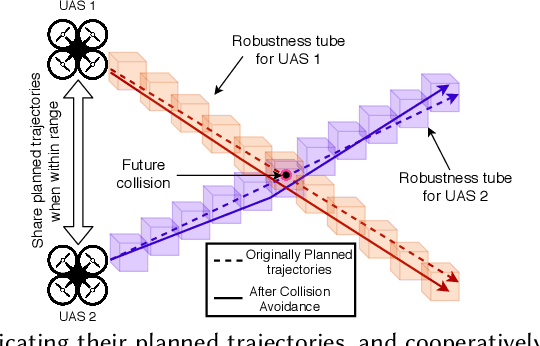
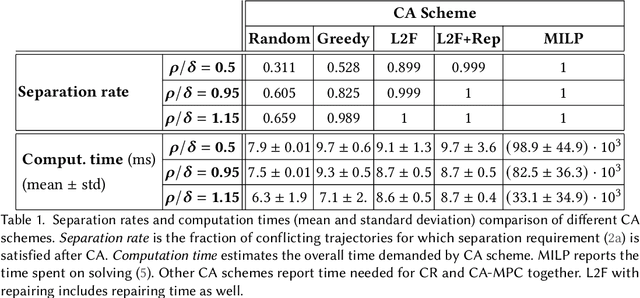


Abstract:Urban Air Mobility, the scenario where hundreds of manned and Unmanned Aircraft System (UAS) carry out a wide variety of missions (e.g. moving humans and goods within the city), is gaining acceptance as a transportation solution of the future. One of the key requirements for this to happen is safely managing the air traffic in these urban airspaces. Due to the expected density of the airspace, this requires fast autonomous solutions that can be deployed online. We propose Learning-'N-Flying (LNF) a multi-UAS Collision Avoidance (CA) framework. It is decentralized, works on-the-fly and allows autonomous UAS managed by different operators to safely carry out complex missions, represented using Signal Temporal Logic, in a shared airspace. We initially formulate the problem of predictive collision avoidance for two UAS as a mixed-integer linear program, and show that it is intractable to solve online. Instead, we first develop Learning-to-Fly (L2F) by combining: a) learning-based decision-making, and b) decentralized convex optimization-based control. LNF extends L2F to cases where there are more than two UAS on a collision path. Through extensive simulations, we show that our method can run online (computation time in the order of milliseconds), and under certain assumptions has failure rates of less than 1% in the worst-case, improving to near 0% in more relaxed operations. We show the applicability of our scheme to a wide variety of settings through multiple case studies.
Co-design of Control and Planning for Multi-rotor UAVs with Signal Temporal Logic Specifications
Sep 30, 2020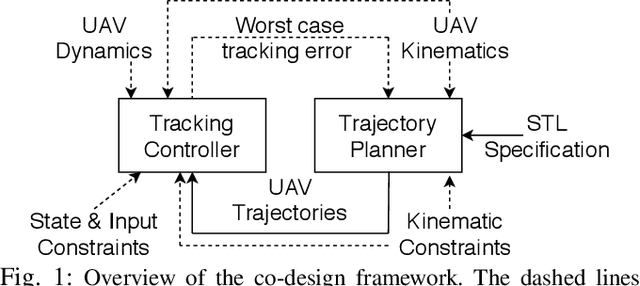
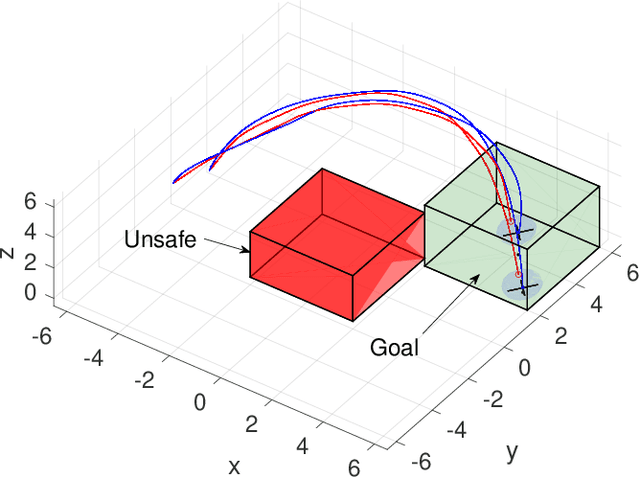
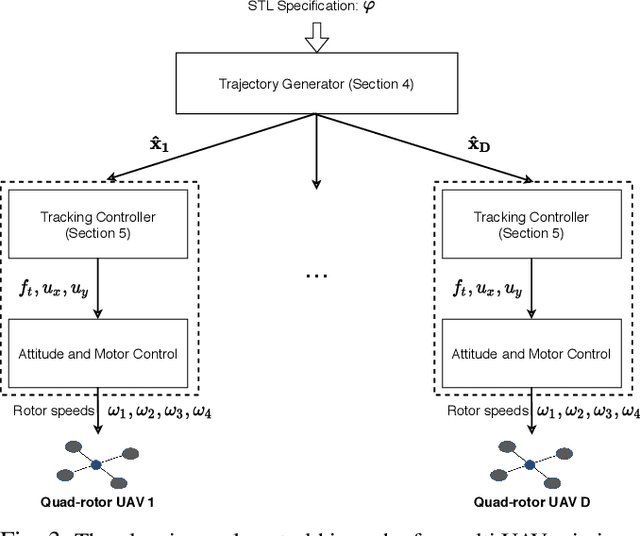
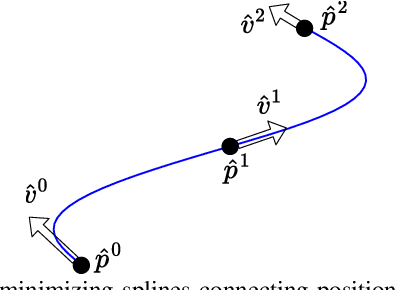
Abstract:Urban Air Mobility (UAM), or the scenario where multiple manned and Unmanned Aerial Vehicles (UAVs) carry out various tasks over urban airspaces, is a transportation concept of the future that is gaining prominence. UAM missions with complex spatial, temporal and reactive requirements can be succinctly represented using Signal Temporal Logic (STL), a behavioral specification language. However, planning and control of systems with STL specifications is computationally intensive, usually resulting in planning approaches that do not guarantee dynamical feasibility, or control approaches that cannot handle complex STL specifications. Here, we present an approach to co-design the planner and control such that a given STL specification (possibly over multiple UAVs) is satisfied with trajectories that are dynamically feasible and our controller can track them with a bounded tracking-error that the planner accounts for. The tracking controller is formulated for the non-linear dynamics of the individual UAVs, and the tracking error bound is computed for this controller when the trajectories satisfy some kinematic constraints. We also augment an existing multi-UAV STL-based trajectory generator in order to generate trajectories that satisfy such constraints. We show that this co-design allows for trajectories that satisfy a given STL specification, and are also dynamically feasible in the sense that they can be tracked with bounded error. The applicability of this approach is demonstrated through simulations of multi-UAV missions.
Learning-to-Fly: Learning-based Collision Avoidance for Scalable Urban Air Mobility
Jun 23, 2020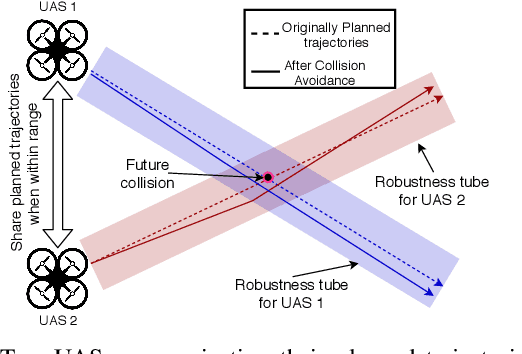

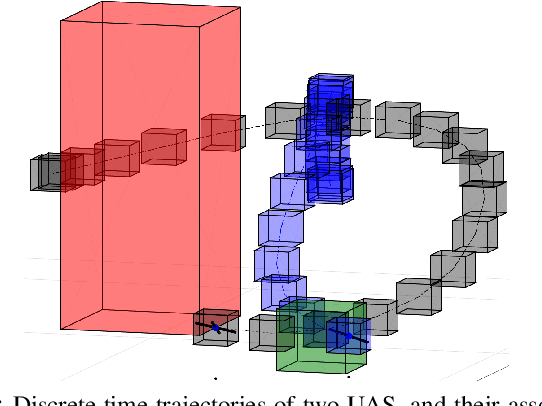
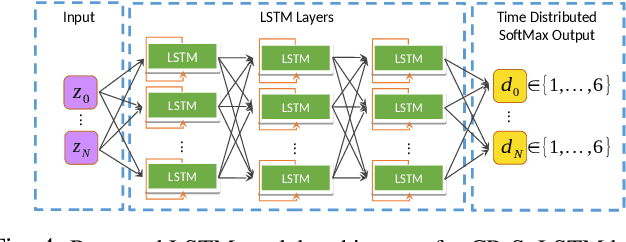
Abstract:With increasing urban population, there is global interest in Urban Air Mobility (UAM), where hundreds of autonomous Unmanned Aircraft Systems (UAS) execute missions in the airspace above cities. Unlike traditional human-in-the-loop air traffic management, UAM requires decentralized autonomous approaches that scale for an order of magnitude higher aircraft densities and are applicable to urban settings. We present Learning-to-Fly (L2F), a decentralized on-demand airborne collision avoidance framework for multiple UAS that allows them to independently plan and safely execute missions with spatial, temporal and reactive objectives expressed using Signal Temporal Logic. We formulate the problem of predictively avoiding collisions between two UAS without violating mission objectives as a Mixed Integer Linear Program (MILP).This however is intractable to solve online. Instead, we develop L2F, a two-stage collision avoidance method that consists of: 1) a learning-based decision-making scheme and 2) a distributed, linear programming-based UAS control algorithm. Through extensive simulations, we show the real-time applicability of our method which is $\approx\!6000\times$ faster than the MILP approach and can resolve $100\%$ of collisions when there is ample room to maneuver, and shows graceful degradation in performance otherwise. We also compare L2F to two other methods and demonstrate an implementation on quad-rotor robots.
Formal Scenario-Based Testing of Autonomous Vehicles: From Simulation to the Real World
Mar 17, 2020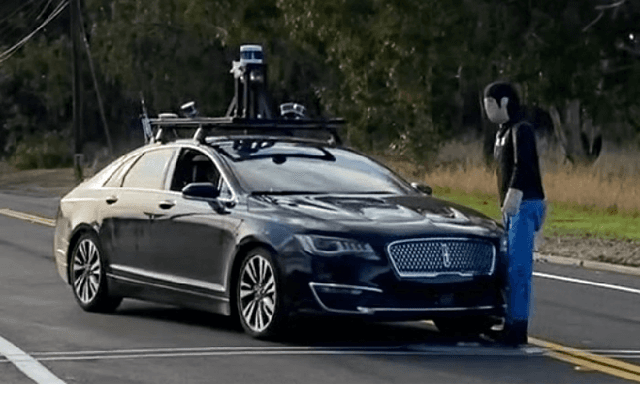

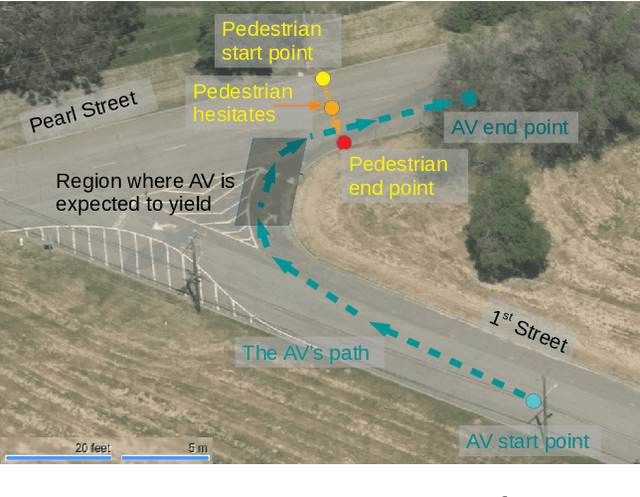
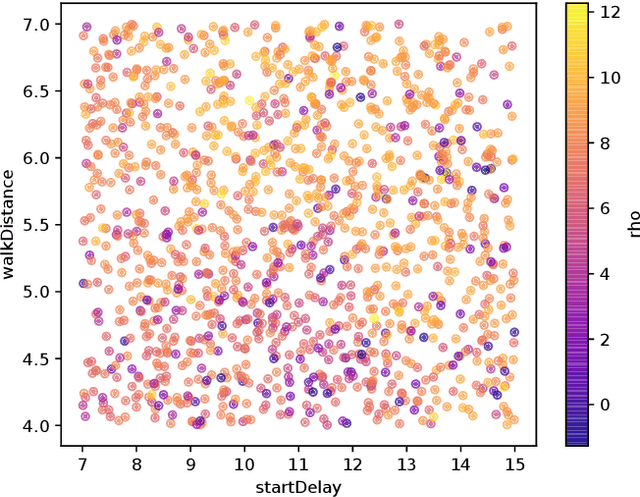
Abstract:We present a new approach to automated scenario-based testing of the safety of autonomous vehicles, especially those using advanced artificial intelligence-based components, spanning both simulation-based evaluation as well as testing in the real world. Our approach is based on formal methods, combining formal specification of scenarios and safety properties, algorithmic test case generation using formal simulation, test case selection for track testing, executing test cases on the track, and analyzing the resulting data. Experiments with a real autonomous vehicle at an industrial testing ground support our hypotheses that (i) formal simulation can be effective at identifying test cases to run on the track, and (ii) the gap between simulated and real worlds can be systematically evaluated and bridged.
 Add to Chrome
Add to Chrome Add to Firefox
Add to Firefox Add to Edge
Add to Edge